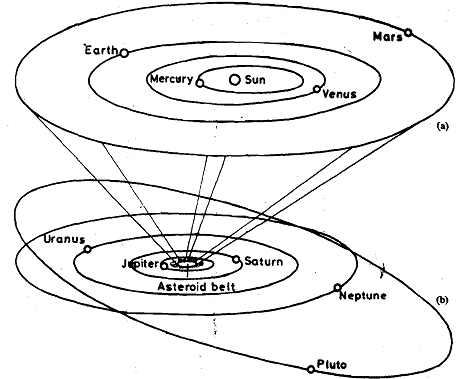solar system
At night you can see very many stars in the sky. But during the day, only one star is .visible, and that is the Sun. This is not because there is anything extraordinary about it but because it is the star closest to us. The light of the other, more distant stars is too feeble to be seen during the day time. The Sun's apparent magnificence had led ancient civ~hsations to think of it as the 'head' of the univeise. Actually, it is only the 'head' of its own family, known as the Solar System. This family consists of :line planets, including the Earth, their satellites, asteroids and comets. Arranged according to their increasing distance from the Sun, the nine planets which go around the Sun are: Mercury (Buddha), Venus (Shukra), Earth (Prith VI), Mars (Mangal), Jupiter ('Brihaspati), Saturn (Sham), Uranus (Arun), Neptune ( Varun), and Pluto ( Yama),. Except for Mercury and Venus, all the planets have big and small satellites going around them. There are also countless asteroids and comets in orbit around the Sun.
All the planets and zsteroids, and some comets, revolve around the Sun in elliptical orbits. They all orbit the Sun in nearly the same plane. youcan inake a fairly accurdte model of the Solar System from a single piece of cardboard on which you can draw the planetary orbits.The only exception of this model is the orbit of. - Pluto, which is inclined at an approrimate angIe of-170 to the general plane of the Solar System. The North Pole of the Earth determines the 'north side' of the Solar System. Seen from the "north side", all planets revolve around the Sun. Its gravitational attraction keeps them tevolving in their orbits. If tbe Sun were to suddenly vanish, the planets wouId all fly off in straight lines at a tangent to their orbits,
The Sun is the dominating member of the Solar System. With a mass calculated to be approximately 2X1023g (grams), it contains almost 99.87% of the mass of the entire Solar System. Of the nine planets, Jupiter and Saturn are the most massive, accountingfor 92% of the mass of all planets. The planets do no generate their own light, like the'Sun does. They shine by reflecting the Sun's light that falls on them. The percentage ofsunlight reflected by any object is directly related to the amount and type of atmosphere that it possesses. Planets or satellites with no atmosphere, such as Mercuryand Moon reflect less light.

All plaliets, except Venus and Uranus, rotate on their axes in the anticlockwise direction. So, on all these, like on the Earth, the Sun rises in the eastand sets in the west. Venus and Uranus rotate in a clockwise direction and as a result, on these two planets the Sun rises in the west and sets in the east! All planets except Uranus have their axes of rotations more or less perpendicular to the plane of orbits (see Fig). The axis of rotation of Uranus is in its orbital plane, as though Uranus had toppled over.